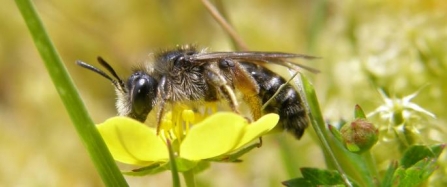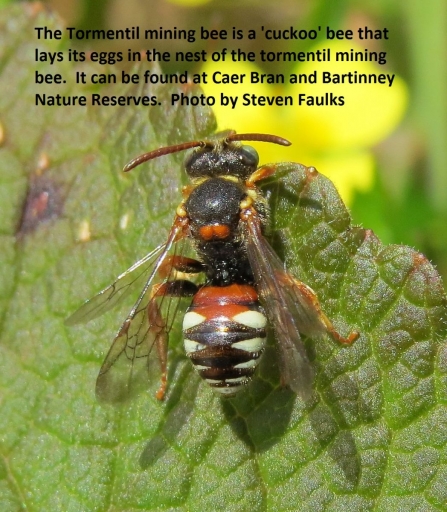
Tormentil miming bee - credit Paddy Saunders

Tormentil miming bee - credit Paddy Saunders
Event details:
• Full title of event: The Wild Cornish Bee Walk
• Date and time of event: Saturday 8th July 2.30pm to 4.00pm
• Where to meet: Bartinney Downs Nature Reserve near St Just
• Cost of event: Free
Joining Friends of the Earth at the Jackson Foundation’s upstairs charity space, the Trust will be celebrating Cornish bees through their displays, illustrating ways people can help pollinators in their own garden and highlighting the importance of wildlife recording.
In addition to this Cornwall Wildlife Trust will be hosting a guided bee walk alongside local bee expert Paddy Saunders and Friends of the Earth. ‘The Wild Cornish Bee Walk’ will take place on the Trust’s Bartinney Nature Reserve near St Just and be led by West Cornwall Reserves Manager Nick Marriott.
At 25 acres, the reserve is a small site but offers a wealth of wildlife including cuckoos, short-eared owls and some very rare bees…
Nick Marriott, West Cornwall Reserves Manager for Cornwall Wildlife Trust says,
“On the walk expect to see meadow pipits, dartford warblers, small heath butterflies, small red damselflies and two of Cornwall’s rarest solitary bees. The site has a very strong population of the rare tormentil mining bee. Not only does the nature reserve have tormentil mining bees but is also one of only six sites in the UK where the tormentil nomad bee has been recently recorded. This bee is a cleptoparasite and lays its eggs in the burrows of the mining bee, the nomad's larvae emerge and eat the host's larvae and stash of tormentil pollen”

Tormentil Nomad Bee - credit Steven Faulk
Cornwall Wildlife Trust manages some of Cornwall’s best bee habitat, this includes grassland, heathland, woodland rides and brownfield sites. Many solitary bees make their nest tunnels in the ground, choosing either bare soil or areas of short turf. Other solitary bees nest in tunnels made in rotten wood, or they make use of vacated tunnels in dead wood made by wood-boring beetles.
The Trust suggest creating your own artificial nest sites by drilling holes 2-8mm in diameter in fence posts or hanging up bundles of hollow plant stems, drinking straws or cardboard tubes.